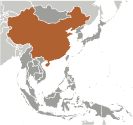
|
|
Advertisements:
People And SocietyNationality
Noun Chinese (singular and plural)
Adjective Chinese Ethnic groups
Han Chinese 91.5%, Zhuang, Manchu, Hui, Miao, Uighur, Tujia, Yi, Mongol, Tibetan, Buyi, Dong, Yao, Korean, and other nationalities 8.5% (2000 census) Languages
Standard Chinese or Mandarin (Putonghua, based on the Beijing dialect), Yue (Cantonese), Wu (Shanghainese), Minbei (Fuzhou), Minnan (Hokkien-Taiwanese), Xiang, Gan, Hakka dialects, minority languages (see Ethnic groups entry) Note Mongolian is official in Nei Mongol, Uighur is official in Xinjiang Uygur, and Tibetan is official in Xizang (Tibet) Religions
Daoist (Taoist), Buddhist, Christian 3%-4%, Muslim 1%-2% Note Officially atheist (2002 est.)Population World Ranking: 1
1,343,239,923 (July 2012 est.)
Age structure
0-14 years
17.6% (male 126,634,384/female 108,463,142) 15-64 years 73.6% (male 505,326,577/female 477,953,883) 65 years and over 8.9% (male 56,823,028/female 61,517,001) (2011 est.) Median age
Total 35.9 years
Male 35.2 years Female 36.6 years (2012 est.) Population growth rate World Ranking: 152
0.481% (2012 est.)
Birth rate World Ranking: 158
12.31 births/1,000 population (2012 est.) Death rate World Ranking: 126
7.17 deaths/1,000 population (July 2012 est.) Net migration rate World Ranking: 131
-0.33 migrant(s)/1,000 population (2012 est.) Urbanization
Urban population 47% of total population (2010)
Rate of urbanization 2.3% annual rate of change (2010-15 est.) Major cities - population
Shanghai 16.575 million; BEIJING (capital) 12.214 million; Chongqing 9.401 million; Shenzhen 9.005 million; Guangzhou 8.884 million (2009) Sex ratio
At birth 1.13 male(s)/female
Under 15 years 1.17 male(s)/female 15-64 years 1.06 male(s)/female 65 years and over 0.92 male(s)/female Total population 1.06 male(s)/female (2011 est.) Maternal mortality rate World Ranking: 116
37 deaths/100,000 live births (2010) Infant mortality rate World Ranking: 111
Total 15.62 deaths/1,000 live births
Male 15.38 deaths/1,000 live births Female 15.9 deaths/1,000 live births (2012 est.) Life expectancy at birth World Ranking: 96
Total population 74.84 years
Male 72.82 years Female 77.11 years (2012 est.) Total fertility rate World Ranking: 180
1.55 children born/woman (2012 est.) Health expenditures World Ranking: 148
4.6% of GDP (2009)
Physicians density
1.415 physicians/1,000 population (2009) Hospital bed density
4.06 beds/1,000 population (2009) Hiv/aids - adult prevalence rate World Ranking: 116
0.1% (2009 est.)
Hiv/aids - people living with hiv/aids World Ranking: 13
740,000 (2009 est.)
Hiv/aids - deaths World Ranking: 14
26,000 (2009 est.)
Major infectious diseases
Degree of risk Intermediate
Food or waterborne diseases Bacterial diarrhea, hepatitis A, and typhoid fever Vectorborne diseases Japanese encephalitis and dengue fever Soil contact disease Hantaviral hemorrhagic fever with renal syndrome (HFRS) Animal contact disease RabiesNote Highly pathogenic H5N1 avian influenza has been identified in this country; it poses a negligible risk with extremely rare cases possible among US citizens who have close contact with birds
(2009) Obesity - adult prevalence rate World Ranking: 66
2.9% (2002)
Children under the age of 5 years underweight World Ranking: 69
8.7% (2000)
Education expenditures
NA
Literacy
Definition
Age 15 and over can read and write Total population 92.2%Male 96% Female 88.5% (2007) School life expectancy (primary to tertiary education)
Total 12 years
Male 11 years Female 12 years (2009)
Comments
Add a new comment: |
Advertisement
Members area
China (Beijing):
 
GPS points from China (Beijing)
|
||||||||

 For centuries China stood as a leading civilization, outpacing the rest of the world in the arts and sciences, but in the 19th and early 20th centuries, the country was beset by civil unrest, major famines, military defeats, and foreign occupation. After World War II, the Communists under MAO Zedong established an autocratic socialist system that, while ensuring China's sovereignty, imposed strict controls over everyday life and cost the lives of tens of millions of people. After 1978, MAO's successor DENG Xiaoping and other leaders focused on market-oriented economic development and by 2000 output had quadrupled. For much of the population, living standards have improved dramatically and the room for personal choice has expanded, yet political controls remain tight. China since the early 1990s has increased its global outreach and participation in international organizations.
For centuries China stood as a leading civilization, outpacing the rest of the world in the arts and sciences, but in the 19th and early 20th centuries, the country was beset by civil unrest, major famines, military defeats, and foreign occupation. After World War II, the Communists under MAO Zedong established an autocratic socialist system that, while ensuring China's sovereignty, imposed strict controls over everyday life and cost the lives of tens of millions of people. After 1978, MAO's successor DENG Xiaoping and other leaders focused on market-oriented economic development and by 2000 output had quadrupled. For much of the population, living standards have improved dramatically and the room for personal choice has expanded, yet political controls remain tight. China since the early 1990s has increased its global outreach and participation in international organizations.